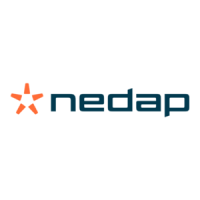Nedap SmartFlow / Installation manual
Version 01.001 / 2021 / EN
39
Dairy Farming
7.2.1 Cleaning agents
Most common cleaning agents combine disinfecting and washing properties but single purpose cleaning agents
are also available. Descaling of the equipment is required on a regular basis and highly depends on the quality of
the water used for cleaning.
• Type and quality: Use good quality cleaning agents intended for cleaning milking equipment and approved
by relevant (national or international) authorities.
• Concentration: Follow the instructions of the manufacturer. Both underdosing and overdosing must be
avoided.
• Storage: Cleaning agents must be stored safely and under the conditions prescribed by the manufacturer
(temperature can be a critical factor!).
• Shelf life: Most cleaning agents have a limited shelf life. Once expired the effectiveness, especially the
disinfecting qualities, can reduce significantly.
• Composition: The materials used in the SmartFlow are resistant to all known cleaning agents for milking
installations. In some cases (especially for cleaning agents containing acids) long contact times must be
avoided. This means that all SmartFlow milk meters need to be drained thoroughly after washing. Proper
draining requires adequate closing and opening of the SmartFlow cleaning valve. The vacuum level in the
milking installation determines the functioning of the valve. To put the SmartFlow in the cleaning mode,
make sure the vacuum level on the valve is higher than the vacuum level in the SmartFlow itself.
Caution
Avoid contact between the SmartFlow and products with chloride, iodine, chloride acid, ketones,
chlorinated hydrocarbons, aromatic hydrocarbons, phenols and higher alcohols to prevent chemical
resistance of the SmartFlow.
7.2.2 Water temperature and flow rate
Water temperature
In circulation cleaning systems, the water temperature during the main wash phase is a critical factor. The
minimum temperature at the end of the main wash phase must be ± 45 ºC (113 ºF) in order to keep the milk
residues (fat) dissolved.
A good timing of the cleaning phases, the amount of (hot) water, covering the wash trough, additional heating
and insulation of parts of the milking installation can contribute to fulfilling this minimum temperature
requirement.
Although the SmartFlow and all its components can resist temperatures up to and above 100 ºC (212 ºF), it is
not recommended to apply hot boiling water washing. The maximum allowed temperature is 75 ºC (167 ºF).
Water flow rate
For the cleaning program a minimal flow rate of 5 kg/min (176 oz./min) is necessary.
7.2.3 Mechanical aspects
The quality and effectiveness of the cleaning process of the milking equipment and the SmartFlow milk meter in
particular, is affected by the following mechanical aspects:
The design and materials of the milk meter
The milk meter is designed to be used in circulating cleaning systems. A specially integrated cleaning program
controls the SmartFlow cleaning valve, which actively supports the quality and effectiveness of the cleaning
process.
The settings of the cleaning program must be synchronized with the manual or automatic cleaning procedures:
See Cleaning program settings (page 40).
The mechanical components of the cleaning process
The mechanical components of the cleaning process are:
• Turbulence
• Column formation in large diameter milk lines
• Speed and persistence of columns

